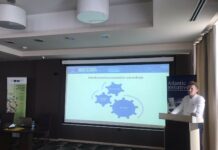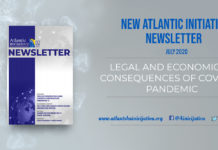Written by: Emina Kuhinja
The Atlantic Initiative organized two webinars entitled ‘Expert Conversation: Talking about Recruitment, Radicalization and New Threats’, conducted as part of the project ‘Research on the Negative Effects of Reciprocal Radicalizations’, funded by the Norwegian Embassy in Sarajevo, Bosnia and Herzegovina. The reason for organizing webinars at the international level is to indicate that radicalization and violent extremism does not happen in a vacuum, and that neither Bosnia and Herzegovina, nor any other country, can be analyzed or viewed in isolation. The pathways of radicalization that are being noticed throughout Europe have the same pattern in BiH, and the topics covered during the webinar were carefully designed. The conversation opened with a discussion on the process of radicalization and whether an individual can self-radicalize. After that, the theme was narrowed down to focus on different aspects of recruitment strategies and the topics which are used to attract the highest number of followers. Finally, after addressing different dynamics of radicalization, the webinar focused in further to talk about the offline harm behind the online radicalization.

The first webinar on ‘Gender, Radicalization and Recruitment’ discussed various topics related to online radicalization. The first discussion addressed ‘memes’ and other visual materials on Instagram and Facebook that are used in the creation of radical groups’ propaganda. Mainstreaming the far-right has become easier as far-right populist rhetoric has become more widespread; with the advancement of modern technologies, the use of visual content has amplified the presence of extremist narratives in the media, enabling it to impact people’s minds and perceptions on a global scale. One topic, rarely addressed, is how right-wing groups use their female members to gain new recruits through social media. This exploitation of the narrative around women has shifted the paradigm and operationalization of extremism. The tactics used in the process of radicalization were addressed during the webinar, with special emphasis given to those which successfully recruit people into different types of extremist groups; ideas of male supremacy; online misogyny; and the polarization of society.
The second webinar on ‘Current Threats and Emerging Trends’ discussed various aspects of current security issues, as well as emerging ones. Underground networks create power centers whose activities emerge publicly only once the damage is done. In times of crisis like the current one, dichotomous, utopian stories have embedded themselves in people’s minds and the message is very clear: liberalism is not as it has been portrayed to be. Discussions that covered the security considerations around extremist networks from the Western Balkans, Europe and the US revealed how online radicalization can manifest itself in the offline world. The rise of authoritarian countries, such as the Russian Federation, that promote conspiratorial discourse and spread public disinformation acts to increase polarization and undermine democratic debate. These actions accelerate the decline in trust in international alliances and organizations, public institutions and the media. With the ongoing power struggle and multilateralism on each side of the political spectrum, the far-right may currently appear only as a mechanism to threaten the other with – but how long until these dynamics lend it the status of a global combatant for power? How is it that the extremists persist in their ideals, and will they generate enough impact to replace currently prevailing norms and values?
Alternative Version of Reality
Elements of visual culture are used for communication and the amplification of extremist voices. Political manipulation and propaganda is now taking place online, but it carries strong implications in the real world. Extremist groups have been employing modern technologies for quite some time now, creating unique content and recruiting people through virtual networks and communities. Studying the visual propaganda and communications by extremist groups can contribute to understanding political extremism from a structural perspective and across various contexts, as well as how their use of media focuses on intimidation and psychological attacks. With that in mind, during the Atlantic Initiative webinar Dr. Charlie Winter used the example of the Islamic State and presented an analysis of its media strategy. He states that at the height of its political, economic and military influence in 2015, the former Islamic State brand formed “a visceral picture of utopia that was far removed from the irrational ‘death cult’ image” that entered the mainstream at the time. It was all about selecting the best bits of daily life in Syria and making a surreal story out of it, luring people into believing the illusion. The conceptualization indicates a doctrine which clearly promotes a dichotomous worldview, violent manifestations of extreme ideas, and warfare, through content that depicts strong and powerful figures living this idealized life. Following on from this example, the discussion evolved into how visual propaganda serves distinct goals, and portrays ideas in accordance with a group’s desired status. A story of existential and excessive warfare targeting Sunni Muslims has legitimized the strategic intentions of the Islamic State, promoting its ideology and providing credibility to its promises of utopia. On the other hand, victimhood plays a role in portraying the defensive operations of the Islamic State – justifying its attacks, but also painting its members as heroes and fighters who have been able to defend themselves and are strong enough to protect others as well. Such content pushes a very serious and ideological message, including appealing elements of brotherhood, security and safety.
Visual propaganda can also communicate a rightward message with a humorous connotation, through what may be perceived as the harmless act of content sharing. Reactionary, xenophobic and often racist extremist groups have managed to portray these ideas as novel, provocative, and in tune with today’s globalized society and digital environment. The images appeal to Internet users – a younger generation in particular – who may shift their notions of what is considered funny on being exposed to radicalizing content. One of the central weapons of extremist doctrine is internet memes (graphics with visual and textual components) shared and distributed online. Distortion of digital discourse and polarization of online interactions are outcomes of this, allowing extremist groups and the far-right to mobilize, recruit and promote their ideology and culture. With technological developments, the Internet has become a catalyst for societal changes, extending its influence into real life. By taking advantage of online space, extremist groups convey their hate messages and propaganda to a wider public through expressions of cultural creativity and the strategic use of memes. Online memes are rapidly gaining attention and reaching broad networks of Internet users, while at the same time generating emotions of empathy and inciting participation. Such dissemination of messages can be explained by the argument that “…boredom is counterrevolutionary. Political resistance needs to be fun, or no one will want to participate.”[1]
Nevertheless, what these distribution processes have in common is the utilization of identical key framings which are used to depict a vision of the perfect life in safe and united communities, and to promote perceptions of an ideal warrior who is courageous and protective – all through devotion and commitment to a certain ideology or religion. Yet, the visual propaganda is not enough on its own to radicalize an individual; the distribution of material is facilitated through people and pre-existing relationships, often via social interactions and conversations online. Dr. Winter argues that visual propaganda only gives the impetus – but radicalization in the context of extremism across the political and ideological spectrum needs to be carried out by real people and recruiting networks. These activities are mostly dominated by male figures and, in the instances where women are included, they are deliberately presented to support the idealist narrative of extremist groups. In discussion with Dr. Greta Jasser, the webinar addressed how far-reaching and engrained in society male supremacy and sexual entitlement are, and the direct link that exists between misogyny and extremism – visible in the pursuit of a social hierarchy which is built on sexist perceptions. This explains why extremist groups often make claims about the “natural order” of things, and believe that it is currently disturbed.
It is relevant to note that in 2018 the Islamic State shifted its narrative, stepping away from its Jihadist norms in releasing a video that depicts female combatants, united in their vision. This was a move that contradicted the traditional and patriarchal norms of extremist groups. However, the adaptability of extremist groups to trends in online spaces must not be undermined. While the Atlantic Initiative has recognized the changing dynamics of recruitment within extremist groups, the webinar – in the discussion with Dr. Eviane Leidig – mentions women in the alternative right, depicting the role of women as the leaders of the movement; as advocates of extremist values and norms; and often as direct recruiters of other women. A story about sisterhood and fulfilling the traditional duties of a woman is put out, with deliberate promotion of anti-feminism and anti-LGBT+ rights, interlinking the personal and political aspect. Within this, feminism is deployed for misogynist and extremist purposes. In the end it comes down to an intentional contradiction of Western values (democracy, liberalism, feminism etc.), with the purpose of framing a political movement and its political and economic goals through a certain religious or other ideology.
Power of the Influencer
Demonizing the enemy, making threats and sharing the ideological story happens publicly, yet the actual operationalization requires underground channels of networking and planning. Recruiters tend to look for weaknesses in order to make personal connections and lure vulnerable individuals into their networks. Discussing the radical milieu creates specific circumstances that lend an open space for deviant forces to impact on society. Religious and socio-economic weaknesses in postwar Bosnia and Herzegovina enabled a radical framework in the context of the Salafi movement, yet not all leaders had recruitment intentions, nor did all members of the Salafi community go to the battlefield. However, building authority and establishing social relations between the leaders and followers within the community is what facilitated a dialogue to be constructed around shared values. From this many other communities emerged, employing a worldview suited to the circumstances of war and relying on the legacy of some postwar ideological leaders, including separatist and ethno-nationalist movements. Extremist leaders, the so-called influencers, have managed to attract and maintain the attention of their followers, luring them in and radicalizing their mindset to the extent that they get recruited as foreign fighters. To have such an impact, specific power centers have been identified – in the research by Dr. Asya Metodieva – which capitalize on their support base and encourage their followers to pursue an extremist path of radicalization. Furthermore, as was addressed during the Atlantic Initiative webinar, ideology-led activities have been shared among domestic radical influencers, but also among the diaspora and pre-existing social networks. With the emergence of social media this impact has been amplified, erasing distances between people and allowing extremist doctrine and its content to reach larger audiences, thus enabling cross-border recruitment.
Social media has formed yet another power center in the virtual world, where the exchange of ideological information and content enables global reach and has developed novelties in terms of ideology and the definition of concepts. Focusing on the growth of online networks and communities, during the webinar Dr. Jasser talked about the broad media coverage of certain content, emphasizing how the Internet extends the outreach of extremist groups and increases the possibility of their content going viral. Nowadays, Internet users can directly engage with content on social media as well as follow up on live streams of certain events or violent attacks. Such content is often published and promoted by social media influencers – who appear among extremists as well – to strong, integrated communities on encrypted apps (e.g. Telegram, Signal etc.) or alt-tech platforms (e.g. Gag, Hatreon etc.), but also mainstream platforms (e.g. Instagram, Facebook etc.). Dr. Leidig notes the use of the phrase “glow up” – signifying one’s engagement in achieving the best version of oneself – by extremist influencers online, who employ it for the purpose of recruitment and radicalization. The power vested in these influencer positions creates forms of micro-celebrity on social media, which often masks their hateful and harmful ideology. Social media has also given more opportunities to female recruiters and far-right supporters to become more ideologically vocal, while mainstream platforms have given them more visibility. Following an extremist influencer online appears just as mainstream as following any other influencer – only in this case, traditional gender norms are discussed through content that primarily promotes women’s role in reproducing the white race. Within that personal life stories are shared which build a connection with the audience, adding a human touch. Once an individual has engaged with content that contains extremist elements, social media algorithms then contribute to wider engagement by suggesting further such content. With that, various power centers are constructed online that can spread out recruitment networks on a global scale.
Malign Tendencies of Foreign States
Social media has also enhanced the impact of other malign tendencies. The strategic position of Russia has been at the center of discussion for years now, posing a question of how – and if at all – its activities have been exaggerated. The public image of Putin’s Russia sends out a strong message of a powerful leader – but of a regime that is not ideological, but rather employs specific ideological elements. Western values and (liberal) democracies perceive Russia as a threat due to its interventions in Western relations and activities. During the webinar, Dr. Anton Shekhovstov argues that when Russia’s intentions to disrupt Western values fail, then the Putin regime turns to the far-right – identifying and targeting societal weaknesses and taking advantage of them for the purpose of maximizing its power status. Furthermore, Putin’s Russia is accused of meddling in inter-ethnic relations among Western Balkan countries, and in Western elections, enhancing internal tensions and strategically aiming to position itself as a superpower. In this context, the far-right is perceived as a tool in the hands of the most powerful countries, used to manipulate and distract the masses. Michael Colborne goes even further in stressing the increased concern and speculation about further escalation of Russian activities in Ukraine, or even a Russian invasion. A high number of foreign fighters have fled to battlefields in Ukraine, employing destructive nationalist rhetoric which is notable even at home. Further debates on the matter include the recent arrests of Russian diplomats in the Czech Republic. With that in mind, Colborne argues that more research should be done on the threats that former foreign fighters now pose to their home country. The international aspect of this situation raises concerns for other states – the Western Balkans in particular – due to the numbers of foreign fighters that have fled from this region, but also due to various political affiliations. Transnational extremist groups have a wider and more significant outreach in times of crisis, where they take advantage of circumstances and seek to position themselves as “truth tellers”. During the webinar Colborne states that while they have not produced the impact they might have expected, their activities must not be underestimated. He discusses those activities in the context of the Western Balkans, where conspiracies and propaganda often disrupt the daily agenda, and talks about how extremist groups can benefit from such a situation. Extremists often insert themselves into current debates and, as Colborne claims, ally with like-minded individuals and groups in criticizing their governments for not working in favour of the people. Such discourse has the potential to impact citizens’ levels of trust, and disrupt democratic processes and institutions.
Tip of the Iceberg
The story of extremism extends far beyond what is often perceived in the media. Images, videos and symbols send out different messages along ideological lines, shaping public perceptions and installing ideas that, through peaceful engagement, promote violent extremism. This depicts how political extremism works from different perspectives across different contexts, employing an approach that is not exclusive to or appropriated only by extremist groups and individuals. No malign influence should be underestimated, and viewing the deployment of the far-right as a strategic tool raises questions about how powerful they currently are, and how much more powerful they will get. What has been perceived so far is limited compared to what lies beneath the surface, and drawing attention to far-right movements and their extremist doctrinal manifestations is something that will without doubt remain on the agenda for the foreseeable future.
Conclusion and Recommendations
An adequate response to the threats posed by extremism and radicalization implies several pillars. These include an institutional response, the regulation of content on social networks, and recognition of and provision of adequate support to vulnerable groups and youth. Analyzing the views expressed during these webinars led to the conclusion that research in BiH on issues such as women’s rights must be understood in the context of the risk of radicalization. Secondly, reciprocal radicalization – in which mutual forms of extremism reinforce and inspire each other, must be better understood. Given the fact that religious and right-wing extremism is closely linked to the subordination of women, we must be vigilant and monitor how these radical attitudes are reflected in the gradual reduction of women’s rights in Bosnia and Herzegovina, and beyond.
Some recommendations discussed during the Atlantic Initiative webinars touched on the different aspects of creating alternative narratives, and preventative practices. It was acknowledged that this should be discussed separately, since the question of alternative narratives – and responding to extremist propaganda in ways that challenge the basis of what extremists groups are trying to communicate and generate – is difficult, and constantly evolving. There needs to be a lot of research that goes into understanding the sentiments of the audiences that are being targeted by extremist groups. It’s not enough to just think; researchers have to dive deep into the narratives that different extremist groups exploit, in order to tackle them correctly.
There are both hard and soft approaches to countering the alt-right online. As Dr. Leidig mentioned, hard approaches include certain policies that tech companies have already put in place to varying degrees. These include suspending accounts for a limited period, content moderation, and demonetization efforts – which can be quite important to understanding the fundraising and financing of these individuals and groups. Other, more technical, aspects include manipulating search results and shifting how algorithms make recommendations (so that, for example, viewing one video on YouTube doesn’t lead to recommendations of similar content). In terms of soft approaches in the online space, one suggestion is to create “alternative” YouTube influencers and bloggers, who can create videos and content debunking extremist narratives in a simple manner.
In terms of offline approaches, governments need to take more account of gender in their counter-extremism programs, and understand the motivations that lead men and women into these different movements. And then, of course, education plays such an important role in building resilient youth.
It was further concluded that the best approach is to identify your own weaknesses and try to heal the wounds, since authoritarian states exploit vulnerabilities and the need of young people to belong, as well as issues around identity and social alienation. As Dr. Shekhovstov said “Putin’s Russia is like a bad doctor: it can identify the weaknesses and wounds making you hurt. A good doctor will try to cure them, to heal the wounds, but a bad doctor – which is the authoritarian regime – will make things worse.”
Find out more about the discussed topics by listening our webinars:
[1] Statement made by the internet activist collective Anonymous, cited in Ferrada Stoehrel, Lindgren (2014: 252) (Ferrada Stoehrel, Rodrigo/Lindgren, Simon (2014): “For the Lulz: Anonymous, Aesthetics, and Affect.” In: TripleC – Communication, Capitalism & Critique, 12/1, pp. 238–264.)








